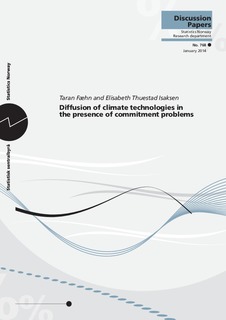| dc.contributor.author | Fæhn, Taran | |
| dc.contributor.author | Isaksen, Elisabeth Thuestad | |
| dc.coverage.spatial | Norway | nb_NO |
| dc.date.accessioned | 2019-11-12T08:16:53Z | |
| dc.date.available | 2019-11-12T08:16:53Z | |
| dc.date.issued | 2014-01 | |
| dc.identifier.issn | 0809-733X | |
| dc.identifier.uri | http://hdl.handle.net/11250/2627827 | |
| dc.description.abstract | Publicly announced GHG mitigation targets and emissions pricing strategies by individual governments may suffer from inherent commitment problems. When emission prices are perceived as short-lived, socially cost-effective upfront investment in climate technologies may be hampered. This paper compares the social abatement cost of a uniform GHG pricing system with two policy options for overcoming such regulatory uncertainty: one with a state guarantee scheme whereby the regulatory risk is borne by the government and one which combines emissions pricing with subsidies for upfront climate technology investments. A technology-rich CGE model is applied that accounts for abatement both within and beyond existing technologies. Our findings suggest a tripling of abatement costs if domestic climate policies fail to stimulate investment in new technological solutions. Since the cost of funding investment subsidies is found to be small, the subsidy scheme performs almost as well as the guarantee scheme. | nb_NO |
| dc.description.sponsorship | Research Council of Norway’s programme RENERG | nb_NO |
| dc.language.iso | eng | nb_NO |
| dc.publisher | Statistisk sentralbyrå | nb_NO |
| dc.relation.ispartofseries | Discussion papers;768 | |
| dc.title | Diffusion of climate technologies in the presence of commitment problems | nb_NO |
| dc.type | Working paper | nb_NO |
| dc.description.version | publishedVersion | nb_NO |
| dc.subject.nsi | VDP::Matematikk og Naturvitenskap: 400::Matematikk: 410::Statistikk: 412 | nb_NO |
| dc.source.pagenumber | 32 | nb_NO |
